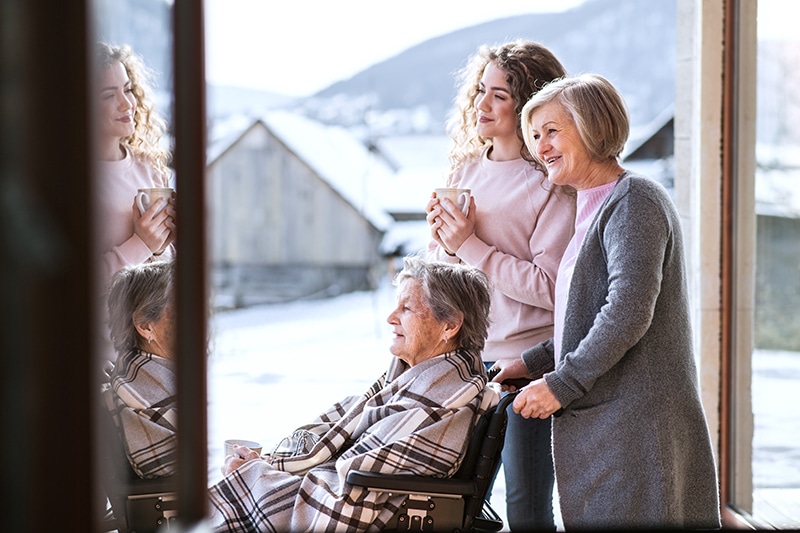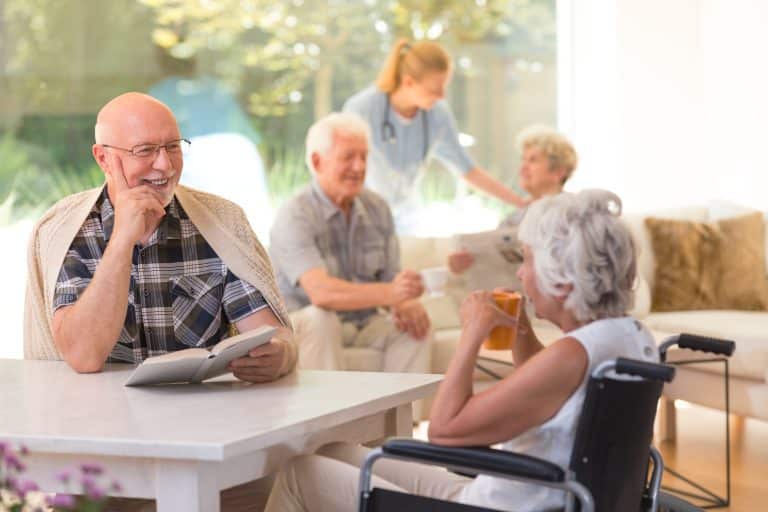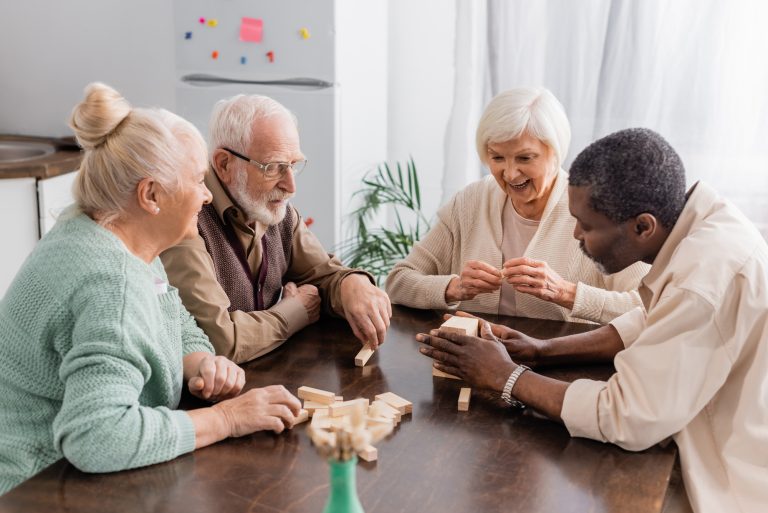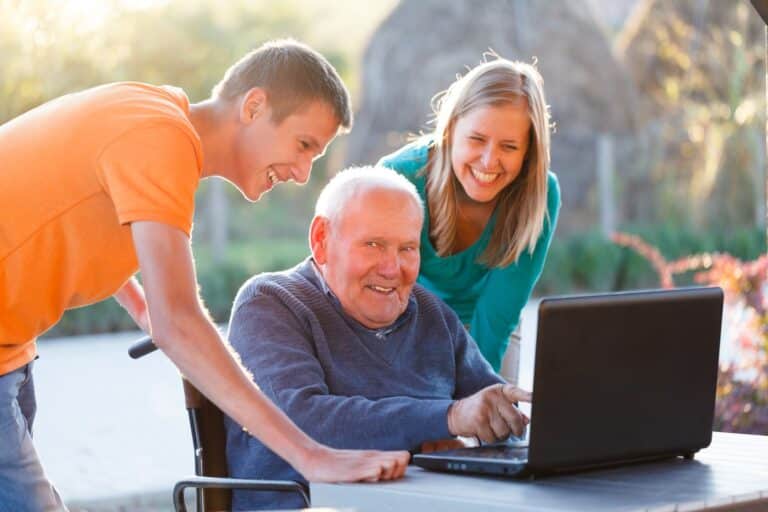Staying Safe and Warm: Winter Health Tips for Seniors
Winter’s chill can be a serious health concern, especially for seniors. While we all love the beauty of a fresh snowfall or the joy of holiday festivities, it’s important to remember that cold weather poses some unique risks for older adults. Our goal is to arm you with vital Winter Health Tips for Seniors, designed to keep you safe and warm during these colder months.
We’ll tackle how aging affects your body temperature regulation and why this makes hypothermia and frostbite more likely in seniors. You’ll learn practical ways to stay snug indoors while preventing dangerous carbon monoxide leaks from fireplaces and gas appliances.
You’ll also receive valuable advice on how to stay active and safe during the chillier months. It’s important to remember that while cold weather might slow down leg movements, they’re still vital! Plus, we don’t overlook discussing how chronic conditions like thyroid issues could influence your capacity to maintain body health. Winter Health Tips for Seniors will be included in our comprehensive guide, offering additional insights and strategies to ensure your well-being during the colder season.
Table Of Contents:
- Understanding the Risks of Cold Weather for Seniors
- Staying Warm and Safe Indoors
- Maintaining Physical Health and Activity
- Recognizing and Responding to Cold-Related Health Issues
- Preparing for Winter Emergencies
- Essential Winter Safety Tips for Seniors
- Protecting Against Carbon Monoxide Poisoning
- Managing Chronic Conditions in Winter
- FAQs about Winter Health Tips for Seniors
- Conclusion
Understanding the Risks of Cold Weather for Seniors
The winter months can be harsh, especially for older adults. The cold weather, coupled with snowy conditions and bad weather in general, presents an increased risk to their health.
Hypothermia, a condition where body temperature drops to an unsafe level, poses a greater risk for seniors due to physiological changes associated with aging. Older adults are more susceptible to changes happening in the body with aging.
The Dangers of Hypothermia and Frostbite in Seniors
Hypothermia isn’t just about feeling cold; it’s far more serious than that. It sets in when your body loses heat faster than it can produce it causing a drop in body temperature. In seniors, this happens quite often as their bodies don’t regulate heat as efficiently anymore.
This drop may lead them into trouble quickly if not identified early on because once set in, they might become too disoriented or exhausted to do anything about it.
Besides hypothermia, frostbite also poses a threat during extreme temperatures. Areas like fingers and toes are most at risk where blood circulation is less optimal – another factor that’s common among elderly folks making them all the more vulnerable.
Carbon Monoxide Poisoning Risk Increases During Winter Months
Apart from these direct effects of cold on the human system, there’s yet another danger lurking around: carbon monoxide poisoning. Heaters we use inside our homes during winter can sometimes leak this deadly gas without us even realizing it until symptoms start showing up.
Staying Warm and Safe Indoors
When the winter chill takes hold, staying warm becomes more than a comfort issue for seniors—it’s a matter of health. The indoor temperature can play a crucial role in this. For starters, it’s recommended to set your heat to at least 68-70°F. This range is often comfortable enough without risking overheating or causing dry skin.
Ensuring Safety from Carbon Monoxide Poisoning
Apart from maintaining warmth, another critical concern during cold days is safety from carbon monoxide poisoning. Fireplaces and gas appliances can be fantastic sources of warmth but also potential hazards if not used correctly.
The key here is regular maintenance checks on these heating devices to prevent leaks—ensuring that they’re properly vented will go a long way towards safety.
Beyond just the source of heat, how you retain that heat matters too. To stay warm indoors effectively during winter months requires some strategy:
- Dress warmly even when inside; layers work best as they trap body heat efficiently.
- If there are unused rooms in your house, close them off to avoid wasting precious energy warming up spaces nobody uses.
In case things get tough financially with higher utility bills due to increased heating needs—a common occurrence over winter—the National Energy Assistance Referral Service (NEAR), and the Low Income Home Energy Assistance Program (LIHEAP) offer help for those who need it.
Staying warm and safe indoors during winter is more than just cranking up the heat. It’s about being smart with how you use and retain that warmth, while also staying mindful of potential hazards like carbon monoxide poisoning. So stay cozy this winter, but do it safely.
Staying warm in winter is more than just turning up the heat for seniors. It’s about using warmth wisely and keeping it where you need it while steering clear of dangers like carbon monoxide poisoning. Checking heating devices regularly, bundling up even when inside, and shutting doors to rooms that aren’t in use can all make a big difference. And remember, if higher utility bills are putting a strain on your budget, don’t be shy—reach out to services like NE for help.
Maintaining Physical Health and Activity
Keeping active in winter is key, but we need to balance this with safety. Snow shoveling can strain the heart – so it’s not just about getting moving, but also doing so wisely. Incorporating Warm and Nutritious Dishes into your winter diet can contribute to your overall well-being, providing the necessary energy and nutrients to support your active lifestyle while ensuring you stay safe in the colder months.
You might think that slower leg movements or trouble walking could keep you from being active during these colder months. But don’t let them discourage you. Even if your pace has slowed down, there are still plenty of ways for seniors to stay fit indoors when weather conditions get tough.
One easy option? Home workouts. You’d be surprised at how much they can help maintain body heat. The truth is, that some medications and lack of physical activity can affect our ability to generate warmth – another reason why keeping up an exercise routine throughout winter is important.
- Light stretching exercises in the morning help loosen stiff joints.
- A brisk walk around the living room keeps the circulation going strong.
- Sitting less often by taking short breaks between sitting periods promotes better blood flow too.
The National Institute on Aging suggests that daily activities like cleaning or even cooking meals count towards maintaining physical health as well. So remember: staying physically engaged isn’t limited only to ‘exercise’ per se – it includes any movement.
If you’re worried about slipping outdoors due to icy conditions (we’ve all been there.), try low-impact indoor activities instead such as yoga or Pilates which are great options for boosting flexibility and strength without risk of injury. Or perhaps dancing? It’s fun AND good for heart health. And yes… shaking those hips counts as staying active.
Let’s not forget about mental health either. Activities like reading, puzzles, or crafts can also play a role in keeping our minds sharp during the winter months.
Staying active is important year-round for seniors – but it becomes even more crucial when temperatures drop. So don’t let the cold keep you from maintaining your physical and mental well-being.
Stay active and warm this winter, seniors. Balance safety with activity – think indoor workouts or light stretches to maintain heat and health. Remember, daily tasks like cooking also count towards physical engagement. For those icy days, try low-impact exercises indoors such as yoga or dancing. And don’t forget mental activities too.
Recognizing and Responding to Cold-Related Health Issues
The cold weather brings unique challenges for seniors, including the risk of hypothermia. But what does this look like? Warning signs include cold feet and hands, a puffy or swollen face, unusually pale skin, uncontrollable shivering, slower speech than normal, sleepiness out of the ordinary, and confusion.
Let’s discuss what to do when these indicators are present. If you suspect someone might be experiencing hypothermia—perhaps their leg movements are slow or jerky—it’s crucial not to ignore these early signs. You should get them into a warm place immediately if possible.
If symptoms persist after moving indoors where it’s warmer with extra covers available—or if you’re unable to move them inside—you need professional medical help right away. This is when having access handy can save lives.
Preventing Hypothermia: Tips & Tricks
Avoidance is always better than treatment when it comes to health issues, especially during winter months since body heat can rapidly drop due to environmental factors around us which leads to complications related to lowered temperatures such as heart attack etcetera – hence prevention key.
You may wonder how clothing choices affect body temperature regulation in seniors but actually, they play an important role in maintaining optimal warmth throughout the day so wearing loose layers made from materials designed to retain warmth (like wool) combined with long underwear under your regular clothes will make sure maintain adequate level heat while going about daily activities; furthermore adding a waterproof coat could prove useful snowy days indeed. Don’t forget to cover extremities well: wearing warm socks and gloves will prevent heat loss from these areas which are particularly vulnerable to cold.
Another preventive step is to maintain a warm home environment. A chilly house may lead to a drop in body temperature for seniors, which can be mitigated by weather-stripping doors and windows to retain heat indoors. It’s also essential to use space heaters cautiously – ensuring they’re situated at least three feet away from any flammable materials.
Keeping an eye out for signs of hypothermia in seniors, especially during winter, is vital. These signs might include a swollen face, pale skin coloration, uncontrollable shivering, and confusion. If you come across any of these symptoms, act swiftly. Get them into a warm environment as soon as possible or seek immediate medical help if the situation calls for it. Prevention is key – bundle up in layers of warm clothing and make sure your home exudes coziness.
Preparing for Winter Emergencies
When winter hits, seniors need to be ready. Power outages can make a cold house even colder and navigating icy roads becomes treacherous.
Your Emergency Kit Essentials
A well-stocked aid kit is crucial. This should include essential items like medications, extra covers to keep warm, and non-perishable food. Also, having a charged cell phone handy will ensure you stay connected during power outage situations.
Consider adding a battery-powered or hand-crank radio in your kit. Staying informed about road conditions helps decide whether it’s safe enough for that much-needed grocery run or doctor’s visit.
Safeguarding Your Home Against the Cold
To prevent heat loss at home, weather stripping around windows and doors works wonders. It keeps the chilly drafts out while trapping precious body heat inside.
If you’re worried about heating bills piling up this season don’t fret. Resources are available to help with these expenses as well as weatherizing homes.
Clothing Choices Can Make All The Difference.
Dressing right is half the battle won against freezing temperatures outside. Start with long underwear – they’re perfect under those loose layers of clothing.
- Always wear socks made from wool or thermal material – nothing sucks out body heat faster than cold feet after all.
- You might want to consider boots with non-skid soles too; icy walkways have seen more than their fair share of slips and falls each year.
In conclusion: Being prepared makes tackling emergencies easier when winter rolls around again next year.
Essential Winter Safety Tips for Seniors
In frigid temperatures and snowy conditions, seniors must take steps to avoid falls and keep warm. Here are some essential tips.
Dressing Right for the Cold Weather
To keep body heat in check, wearing long underwear beneath your clothes is a smart move. But don’t stop there. Loose layers help trap warm air close to your body, so wear long-sleeved shirts over your thermal underwear.
If you’re heading outside, put on a waterproof coat that also shields against the wind—a common culprit behind the rapid loss of body heat—and boots with non-skid soles are an absolute must-have item during icy weather. To protect yourself from frostbite make sure you wear socks – thick ones.
Finally, don’t forget accessories like gloves and hats; they provide vital protection against cold temperatures by reducing heat loss through the extremities. The CDC suggests keeping these items near exits so you never leave home without them.
Maintaining Indoor Temperature
Avoiding hypothermia starts at home—specifically with indoor heating systems that maintain warmth even when it’s freezing outside. Setting your thermostat between 68-70°F will ensure this comfort while closing off unused rooms helps conserve energy as well. You can also contact the National Energy Assistance Referral Service (NEAR), or Low Income Home Energy Assistance Program (LIHEAP) for assistance.
Sometimes, though, the cold sneaks in through tiny cracks and spaces. In such cases, weather stripping is a cheap but effective way to seal these leaks.
Space heaters can be handy for extra warmth too; just remember not to use them while sleeping or leave them unattended due to carbon monoxide poisoning risks.
Don’t forget, layering up is key to bracing the winter chill – begin with long underwear and pile on loose layers. As you step outside, make sure to wear a waterproof coat, non-skid boots, thick socks gloves, and a hat for complete protection against frostbite. Keep your home warm and cozy at 68-70°F by using indoor heating systems. Also, it’s important to seal off any cold drafts with weather stripping.
Protecting Against Carbon Monoxide Poisoning
The winter months can pose a risk of carbon monoxide poisoning, especially for seniors who use fireplaces, wood, and gas stoves to stay warm. If not properly vented, these heat sources can leak dangerous amounts of carbon monoxide.
Safety Measures Against Carbon Monoxide Leaks
To protect against this silent killer, make sure your heating devices are in good working condition. Get them serviced by professionals before the cold weather starts. This helps prevent any malfunctions that could lead to leaks.
You should also install carbon monoxide detectors near sleeping areas and check their batteries regularly. These alarms give an early warning sign if there’s too much of this harmful gas in your home.
Another essential safety measure is proper ventilation. Keep flues and chimneys clear from debris or bird nests which might block exhaust gases from escaping outside. This guide on reducing fire hazards for portable electric heaters provides more detailed information about safe usage during winter.
If you feel sick, like a headache, dizziness, or nausea when using a heater or fireplace, it could be from breathing in carbon monoxide. It’s crucial to leave the area immediately and seek help if such signs occur as they indicate potential poisoning.
Besides being cautious indoors with heaters and other appliances that produce combustion fumes; ensuring proper car maintenance is equally important too. Vehicles left running in garages attached to homes pose another common source of this poisonous gas intrusion into living spaces.
Note: Maintaining outdoor generators at least 20 feet from windows prevents lethal buildups inside homes.
Managing Chronic Conditions in Winter
As winter chills take hold, seniors must manage chronic conditions like thyroid problems and diabetes. These illnesses can affect body heat and make it more challenging to stay warm.
Your thyroid, the small butterfly-shaped gland at the base of your neck, plays a significant role in regulating your metabolism and body temperature. A low thyroid hormone production, called hypothyroidism, can lead to feeling colder than usual; therefore smart dressing is essential.
This is where smart dressing comes into play. Layer up with loose layers of clothing. Remember: heat gets trapped between these layers making you warmer than wearing one heavy piece would. Also, consider adding extra covers on your bed at night.
If managing diabetes, keep an eye out for warning signs that could indicate issues with blood sugar levels due to colder temperatures or changes in diet during holiday seasons. Symptoms might include feeling unusually tired or having blurry vision. Regularly monitoring blood glucose levels is key here.
Maintaining Indoor Temperature
A cold house isn’t just uncomfortable—it can also lead to serious health problems like hypothermia—a drop in body temperature that occurs when your body loses heat faster than it produces it.
To prevent this risk, aim to maintain indoor temperatures between 68-70°F (20-21°C). Using weather stripping around windows and doors will help seal off drafts keeping warmth inside where you need it most.
Talking To Your Healthcare Provider
In some cases, medicines taken by seniors might affect their ability to regulate their body heat leading them to lose more heat compared to normal times. So, always have a chat with your healthcare provider to discuss how the medicines might affect you in winter.
Keeping these tips and information in mind can help make winter more manageable for seniors dealing with chronic conditions like thyroid problems or diabetes. It’s all about understanding what works best for you, keeping warm, and maintaining an open line of communication with your doctor.
Beating the Winter Blues: For seniors, managing chronic conditions like thyroid issues and diabetes is vital in winter. Layering up clothing traps heat better than a single heavy piece does. Regularly check blood glucose levels if you have diabetes. Maintain indoor temperatures between 68-70°F to prevent hypothermia risks. It’s also important to keep an open line of communication with your healthcare provider for any health concerns.
FAQs about Winter Health Tips for Seniors
What temperature is too cold for seniors?
Cold weather can be risky for seniors. Ideally, their living space should stay around 68-70°F to maintain comfort and safety.
How can seniors stay active in winter?
Snow shoveling aside, indoor activities like yoga or simple leg movements help keep the blood flowing during chilly months.
How do you keep your body warm in old age?
Dressing warmly in layers, staying indoors with adequate heating, and regular physical activity all contribute to keeping warm as we age.
What is the ideal room temperature for an elderly person?
To avoid hypothermia risks, it’s recommended that older adults maintain a minimum indoor temperature of 68-70°F throughout winter.
Conclusion
As the winter chill sets in, seniors must be equipped with the knowledge and precautions necessary to navigate the colder months safely and comfortably. The plummeting temperatures bring with them increased risks of hypothermia and frostbite, particularly for older adults whose bodies may struggle with lower temperature regulation. Taking proactive measures to keep warm becomes paramount during this time. To ensure the well-being of seniors in winter, it’s essential to incorporate effective strategies that address the unique challenges they may face. Winter Health Tips for Seniors can play a vital role in promoting their safety and overall health during the colder season.
One key aspect of safeguarding against the cold is maintaining a cozy home environment. While enjoying the warmth of fireplaces or gas appliances, it’s essential to simultaneously ensure safety from potential carbon monoxide leaks. This dual consideration ensures that the warmth you seek doesn’t compromise your well-being.
Engaging in physical activities is vital for overall health, even in winter. However, seniors need to approach such activities with caution. Snow shoveling, for instance, can place undue strain on the heart, making it crucial to exercise prudence and, if necessary, seek assistance with strenuous tasks. Additionally, individuals with chronic conditions such as thyroid issues should be mindful, as these can impact the body’s ability to regulate temperature effectively.
Therefore, as the snow blankets the landscape and winter sets in, here’s a gentle reminder to prioritize your health. Embrace the season by implementing these winter health tips into your daily routine. By staying vigilant against the cold’s potential threats, you can ensure a safe and enjoyable winter experience. If you or a loved one resides in an assisted living facility in Gilbertsville, these tips become even more crucial in maintaining well-being during colder months. So, here’s to a season filled with warmth, good health, and the simple joys that winter brings.







